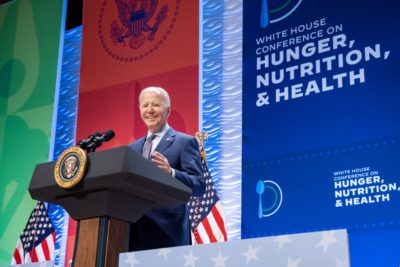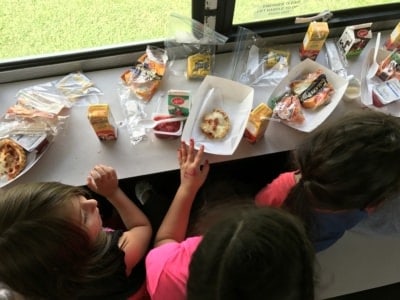

Share this story
- From transportation to books, schools provide students with various resources at no cost to them to help them be successful. North Carolina's school nutrition leaders are trying to add meals to that list. #nced @nokidhungryNC @carolina_hunger @ncschoolmeals
- Federal legislation could be critical to helping districts provide free meals by addressing staffing shortages, supply chain problems, the impacts of inflation, and rapidly growing school meal debt. #nced
|
|
From transportation to books, schools provide students with various resources at no cost to them to help them be successful. North Carolina’s school nutrition leaders are trying to add meals to that list.
The Carolina Hunger Initiative held a debrief this week following the recent White House Conference on Hunger, Nutrition, and Health.
“Kids are provided books, they are provided transportation to schools – so why not feed the kids for free as well?” asked Ruth McDowell, president of the School Nutrition Association of North Carolina and director of school nutrition services for Edgecombe County Public Schools.
At September’s White House conference, the Biden-Harris administration stated their intention to provide a pathway toward free school meals for every student, starting with a plan to ensure that at least 9 million more children across the United States have access to free school meals by 2032.
“We’re really excited about this goal,” said Andrew Harrell, program and communication manager for the Carolina Hunger Initiative.
Harrell said that 2032, however, may even be a little too far away.
“We think we can get it done here sooner in North Carolina,” said Harrell.
Reauthorization of federal child nutrition legislation critical first step
The Biden-Harris administration’s national goal of expanding free school meals to 9 million more children relies in part on $8 billion in private- and public-sector partnerships and commitments – as well as bipartisan support in Congress to secure the public dollars needed to make this goal accessible and equitable.
One key mechanism for moving toward this ambitious goal? Reauthorizing the federal Healthy, Hunger-Free Kids Act of 2010, which is now seven years past due.
“There are some key provisions in the reauthorization, as it is currently written, that will have a tremendously positive impact on school meals,” said Lynn Harvey, senior director for the Office of School Nutrition and Office of District Operations at the state Department of Public Instruction.
Those key provisions include making adjustments to the Community Eligibility Provision (CEP), which enables schools and districts to provide free school meals to all students. Adjustments include lowering the eligibility threshold for a school or district to qualify for the CEP, raising the multiplier for federal reimbursement rates for school meals, and creating a statewide eligibility option.
[Learn more about Community Eligibility Provision (CEP) and the basics of how school meals are funded here.]Federal child nutrition reauthorization is critical for North Carolina at a time when the state continues to face so many challenges when it comes to feeding its students. Advocates say reauthorization of the 2010 bill has been on the move on Capitol Hill this session and has a better shot at passage now than in recent years.
Staffing shortages, supply chain problems, and the impacts of inflation on schools and families are the top barriers that nutrition directors face as the schools in their districts work to distribute thousands of meals each day, Harvey said.
Another major challenge districts are facing is rapidly accumulating school meal debt.
“With 90 public school districts reporting, we are at just about $1 million in school meal debt as of (Oct. 26),” said Harvey. “That’s an unprecedented amount of school meal debt, and it’s become quite a source of conversation among local boards of education, because they will find themselves having to be responsible for that meal debt.”
Harvey cautioned that while some may assume that school meal debt is largely occurring because families aren’t filling out the free- and reduced-price meals application, that’s not what she’s hearing. Instead, many families are finding that they are just above the threshold for qualifying for free- or reduced-price meals, and that translates to school districts incurring meal debt to feed kids who might otherwise go without food.
DPI has voluntarily agreed to report on school meal debt to policymakers in the General Assembly so they can understand in real time how meal debt is impacting students, families, communities, and schools. And as they do that, they’ll continue to emphasize the importance of federal child nutrition reauthorization, which would serve as a critical lever for ensuring children’s nutritional needs are being met.
“And keep in mind, the message is not just about ‘let’s get reauthorization for school meal programs as quickly as we can,’” said Harvey. “Let’s make sure the language in reauthorization that is there now stays – because that’s where we have the greatest protection when it comes to supporting the CEP and ultimately achieving our goals of meals for all at no cost.”
Shifting viewpoints: School meals for all is an academic intervention
At September’s White House conference, Burke County, Georgia’s School Nutrition Director Donna Martin said research tells us what we need to know about school meals – that they are the healthiest meals in America for children to eat and that universal school meals for all would improve health and academic outcomes, and support local agriculture.
“It is not hard, universal school meals,” said Martin. “Universal – or what I like to call healthy school meals for all – these meals are based on dietary guidelines. By offering this, we would cut out the stigma. We cut out the lunch debt.”
Here in North Carolina, that sentiment appears to be shared among child nutrition advocates. The North Carolina Alliance for Health announced during this week’s event the creation of the School Meals for All Campaign, in partnership with the Carolina Hunger Initiative, The Center for Black Health and Equity, and A Better Chance A Better Community.
The campaign, said Katie Herndon Dawkins, communications manager for the NC Alliance for Health, will work to secure funding for school meals for all so that every child in every public school has access to breakfast and lunch at no cost to their families.
“The national strategy on hunger, nutrition, and health includes school meals for all, and we think this is a huge victory,” said Herndon Dawkins. “However, the strategy doesn’t push for healthy school meals for all right now. And that is why a school meals for all campaign in North Carolina is incredibly important.”
DPI’s Harvey said it’s time for school meals to be talked about and considered like any other instructional device students use.
“School meals are like transportation to and from school. School meals are like digital devices that children now need in order to keep pace with a fast moving educational environment,” Harvey said. “They’re like any of the other resources that we provide to students to make sure they have our best, so they can do their best.”





